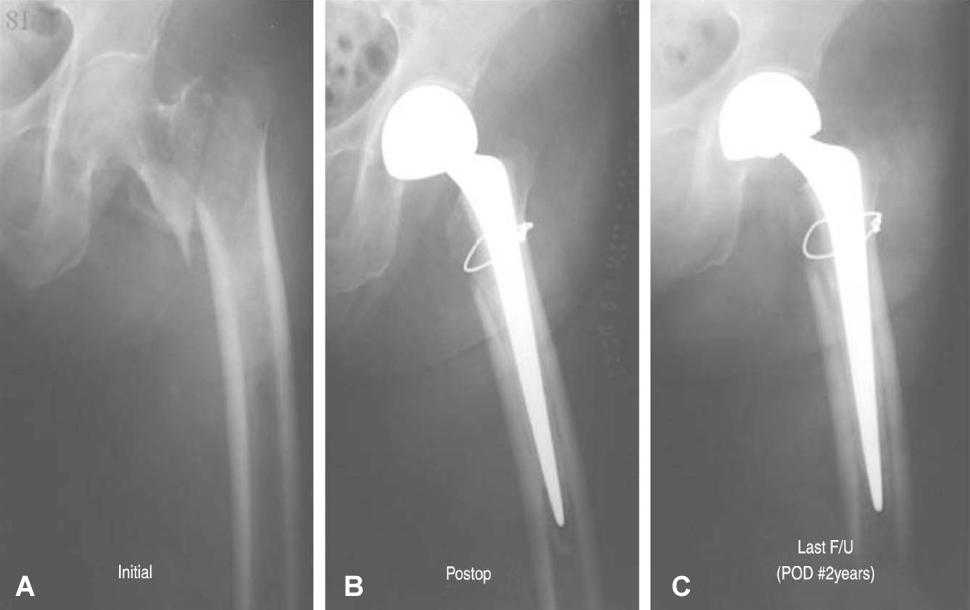J Korean Hip Soc.
2010 Sep;22(3):209-215. 10.5371/jkhs.2010.22.3.209.
Cemented Bipolar Hemiarthroplasty for Intertrochanter Fracture in Elderly Patients: Minimum 2-Years Follow-up Results
- Affiliations
-
- 1Department of Orthopedic Surgery, Wonju College of Medicine, Yonsei University, Wonju, Korea. hwtonlka@yonsei.ac.kr
- KMID: 1461172
- DOI: http://doi.org/10.5371/jkhs.2010.22.3.209
Abstract
- PURPOSE
The purpose of this study was to evaluate the usefulness of bipolar hemiarthroplasty using a cemented femoral stem for treating femoral trochanteric region hip fractures in elderly patients.
MATERIALS AND METHODS
This study includes 47 hips were available to be follow up for over 2 years, between December 1995 and December 2002. Clinical evaluation was done using Koval's classification before the fracture and at last follow-up, and Harris's hip score at the last follow up. Radiological evaluation was done via the plain radiographs.
RESULTS
The Koval classification was as follows: recovery to the condition before fracture in 15 cases (31.9%), degradation by 1 class in 31 cases (66.0%) and degradation by 2 classes in 1 case (2.1%). The Harris hip score was 84.6 points at the last follow-up. All the cases showed stable fixation of the femoral stem. Postoperative complications were reported as 1 case of pneumonia, 1 case of deep vein thrombosis, 1 case of pulmonary thromboembolism, 1 case of pulmonary edema, 3 cases of stress ulcer, 1 case of superficial infection and 1 case of deep infection. Superficial pressure sore occurred in 1 case, postoperative delirium occurred in 9 cases and partial rupture of the bladder in 1 case.
CONCLUSION
Bipolar hemiarthroplasty using a cemented femoral stem was effective and satisfactory for the treatment of elderly patients with intertrochanter fractures. But further studies that will focus on complications are required.
MeSH Terms
Figure
Reference
-
1. Bickel WH, Jackson AE. Intertrochanteric fractures of the femur; an analysis of the end results of 126 fractures treated by various methods. Surg Gynecol Obstet. 1950. 91:14–24.2. Cobelli NJ, Sadler AH. Ender rod versus compression screw fixation of hip fractures. Clin Orthop Relat Res. 1985. 201:123–129.
Article3. Kang CN, Kim JO, Kim DW, Koh YD, Ko SH, Lee KW. Comparison of hemiarthroplasty and Compression hip screw on elderly unstable intertrochanteric fractures. J Korean Soc Fracture. 1997. 10:738–745.
Article4. Park MS, Choi SS. Bipolar hemiarthroplasty for the treatment of femoral neck and unstable intertrochanteric fracture in elderly patients. J Korean Orthop Assoc. 1991. 26:482–488.
Article5. Khan RJ, MacDowell A, Crossman P, et al. Cemented or uncemented hemiarthroplasty for displaced intracapsular femoral neck fractures. Int Orthop. 2002. 26:229–232.
Article6. Haentjens P, Casteleyn PP, Opdecam P. Primary bipolar arthroplasty or total hip arthroplasty for the treatment of unstable intertrochanteric and subtrochanteric fractures in elderly patients. Acta Orthop Belg. 1994. 60:Suppl. 124–128.7. Kim YH, Park KC, An SC, Choi IY. Bipolar hemiarthroplasty using cement for the treatment of intertrochanteric femoral fracture in elders - 2 to 5 year results. J Korean Hip Soc. 2001. 13:330–337.8. Ling RSM. Cememting technique in the femur. Tech Orthop. 1991. 6:34–39.9. Koval KJ, Skovron ML, Aharonoff GB, Meadows SE, Zuckerman JD. Ambulatory ability after hip fracture. A prospective study in geriatric patients. Clin Orthop Relat Res. 1995. 310:150–159.10. Kelly AJ, Lee MB, Wong NS, Smith EJ, Learmonth ID. Poor reproducibility in radiographic grading of femoral cementing technique in total hip arthroplasty. J Arthroplasty. 1996. 11:525–528.
Article11. Gruen TA, McNeice GM, Amstutz HC. "Modes of failure" of cemented stem-type femoral components: a radiographic analysis of loosening. Clin Orthop Relat Res. 1979. 141:17–27.12. Emery RJ, Broughton NS, Desai K, Bulstrode CJ, Thomas TL. Bipolar hemiarthroplasty for subcapital fracture of the femoral neck. A prospective randomised trial of cemented Thompson and uncemented Moore stems. J Bone Joint Surg Br. 1991. 73:322–324.
Article13. Kim YH, Song SJ, Choi IY. Cemented bipolar hemiarthroplasty for the hemoral intertrochanteric fracture in elderly patients. J Korean Hip Soc. 1998. 10:149–155.14. Carrington NC, Sierra RJ, Gie GA, Hubble MJ, Timperley AJ, Howell JR. The Exeter Universal cemented femoral component at 15 to 17 years: an update on the first 325 hips. J Bone Joint Surg Br. 2009. 91:730–737.15. Rowe SM, Chung JY, Yoon TR, Lee JJ, Bae BH, Chi J. An epidemiologic study of hip fracture - a comparison between 1991 and 2001. Proceeding of annual spring meeting. 2003. The Korean Society of Bone Metabolism.16. Rowe SM, Yoon TR, Ryang DH. An epidemiological study of hip fracture in Honam, Korea. Int Orthop. 1993. 17:139–143.
Article17. Sierra RJ, Timperley JA, Gie GA. Contemporary cementing technique and mortality during and after Exeter total hip arthroplasty. J Arthroplasty. 2009. 24:325–332.
Article18. Ereth MH, Weber JG, Abel MD, et al. Cemented versus noncemented total hip arthroplasty--embolism, hemodynamics, and intrapulmonary shunting. Mayo Clin Proc. 1992. 67:1066–1074.
Article
- Full Text Links
- Actions
-
Cited
- CITED
-
- Close
- Share
- Similar articles
-
- Cemented Hemiarthroplasty in Femoral Neck Fractures over 70 Years : A Matched-Pair Analysis of unipolar and Bipolar Hemiarthroplasty
- Bipolar Hemiarthroplasty for the Treatment of Displaced Femoral Neck Fracture in Elderly Patients: Uncemented versus Cemented femoral stems
- Treatment of Unstable Intertrochanteric Fracture in Elderly Patients : Comparison between the Results of Internal Fixation Using Compression Hip Screw and Cemented Bipolar Hemiarthroplasty
- Cementless Bipolar Hemiarthroplasty for Hip Fracture in Patients More than Seventy Years Old with Osteoporosis
- Standard Type Cemented Hemiarthroplasty with Double Loop and Tension Band Wiring for Unstable Intertrochanteric Fractures in the Elderly



